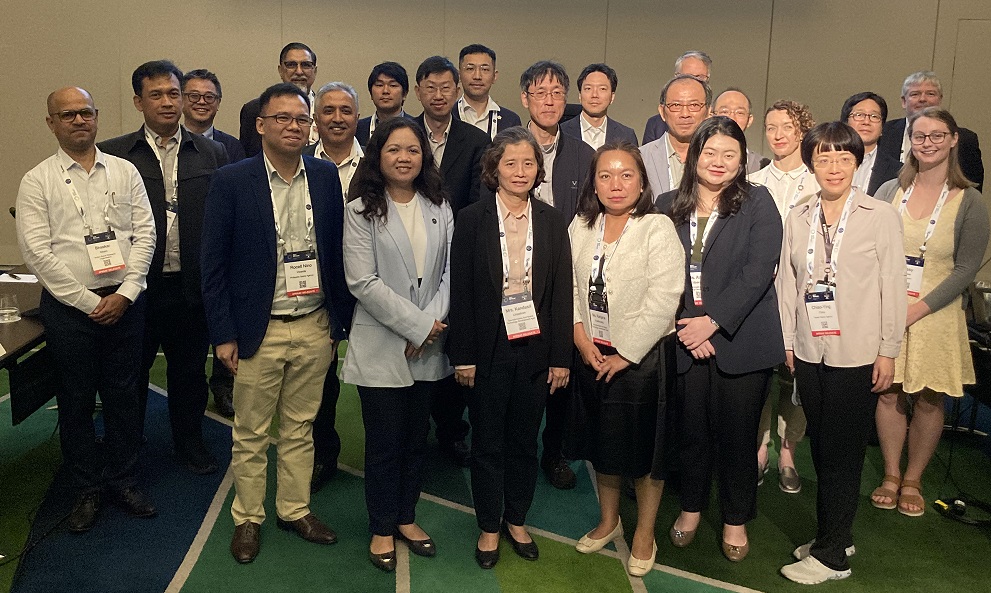Report of the APRSAF/SAFE Executive Board Meeting at APRSAF-30 in Perth, Australia
< Last Update: Dec. 13, 2024 >
The APRSAF/SAFE Executive Board Meeting was held on November 25, 2024. It was co-chaired by Dr. Shashikant Sharma (Indian Space Research Organisation (ISRO)) and Dr. Shinichi Sobue (Japan Aerospace Exploration Agency (JAXA)). The main topic of meeting was discussing on progress and future plan of three SAFE projects, SAFE Agromet Project, SAFE Rice Monitoring Project, and SAFE CH4Rice (Assessment of Methane Emission from Rice Paddies and Water Management) Project.
The participants confirmed the good progress of the two ongoing SAFE projects (Rice Crop Monitoring led by GISTDA and CH4Rice led by VNSC), and also confirmed the successful completion of the Agromet project at the APRSAF-30/SAWG on November 26, 2024 and its achievements including its contribution to regional food security through the provision of validated satellite-derived agromet data to ASEAN countries with capacity building events. It is expected to expand this activity to South Asia under ISRO-JAXA cooperation and other framework. As future work of CH4Rice project, further discussions and collaborations between the public and private sector stakeholders on carbon credit training and IoT devices for water-level and CH4 flux in-situ measurements was outlined.


Result of the APRSAF/SAFE Executive Board Meeting
1. Agromet Project
- Summary
- Confirmed the completion of the SAFE Agromet Project at the APRSAF-30/SAWG tomorrow, with the final report by ISRO as a project lead.
- Hold project completion ceremony at the APRSAF-30/SAWG, and AFSIS manager (Dr. Sumanya) will give the letter of appreciation the the Agromet project, ISRO representative will receive the letter as SAFE Agromet Project leader.
- Discussion and Future Plan
- After the project’s completion, the dialogue between AFSIS and other potential Agromet data users will continue under SAFE and the ISRO-JAXA agreement.
- Congratulated the team on successfully completing the project.
- Try to expand the project across especially the South Asian region.
2. Rice Monitoring Project
- Summary
- The project’s progress was presented, with multilateral cooperation between agencies including GISTDA, ISRO, and JAXA.
- Confirmed capacity building on rice mapping for MoA officers using a data analysis platform, in collaboration with AFSIS and MAFF/Japan.
- Welcomed the approval of a JAIF (Japan-ASEAN Integration Fund) proposal titled 'Improvement of Paddy Rice Area Statistics and Damage Assessment using Earth Observation Satellite for ASEAN,' led by GISTDA.
- Confirmed the demonstration of the utilization of SAFE Asses (rice mapping software) by private company for agribusiness.
- At this APRSAF (APRSAF-30), collaborative sessions with private sector are scheduled on SAWG Day2
- Discussion and Future Plan
- Upgrade rice mapping tools based on results of cross-comparison studies.
- Continue to ingest latest ALOS-2 into the ISRO’s VEDAS and GEE for various users for science, governmental and business purposes.
- Continue the dialog with end-users including governmental officers in statistical department to utilize SAFE project result in their operational work in collaboration with AFSIS.
- Continue the dialog with private sector for the utilization of project achievements to agriculture related businesses. Work with AFSIS to expand the project to the commercial sector.
- Conduct the approved JAIF proposal the inception meeting and 1st training will be held in 22-24 January 2025 at GISTDA (HQ and ARTSA) in collaboration with AFSIS.
- ISRO demonstrated improvements of VEDAS, which will be elaborated on at the next opportunity (e.g. SAFE EBM). Use VEDAS to promote the activities of SAFE (e.g. hosting the INAHOR on the VEDAS).
3. CH4Rice Project
- Summary
- Presented the progress of each study area for the installation of in-situ water level and CH4 flux measurement devices.
- In-situ water-level measurements are being compared with ALOS-2 PALSAR-2 full-pol data.
- Outlined the discussions between the public and private sector stakeholders on carbon credit training and IoT devices for water-level and CH4 in-situ measurements.
- Sharing the CH4 flux measurement equipment (low-cost) by RYNAN, Vietnam
- Discussion and Future Plan
- Continue to conduct field surveys, in-situ water-level measurements using both IoT devices and manual methods, and CH4 flux monitoring.
- Conduct the comparison of in-situ water-level with ALOS-2 PALSAR-2 Full-pol data in study areas over Asian region.
- Coordinate and cooperate with private companies’ activities (carbon credit related businesses) and propose satellite usage to the guideline documents by Verra/Gold standard/JCM, etc. with donor agencies (JICA, ADB etc.).
- Investigate opportunities for collaboration with commercial methane monitoring satellites, to supplement in situ observations of methane emissions.
- Hold a workshop to share technical information among space agencies and to expand the project activities/result with stakeholders on 21 January 2025, Bangkok
- Integrate ALOS-4 observations when available to increase observation frequency, demonstrating use of both ASC and DESC orbits.
- Confirmed the necessity of low-cost CH4 flux measurement equipment. Discuss with RYNAN and other potential companies about promoting these activities.
- Share feedback from the SIWS-SAWG joint session regarding carbon credits (held on SAWG Day 2).
